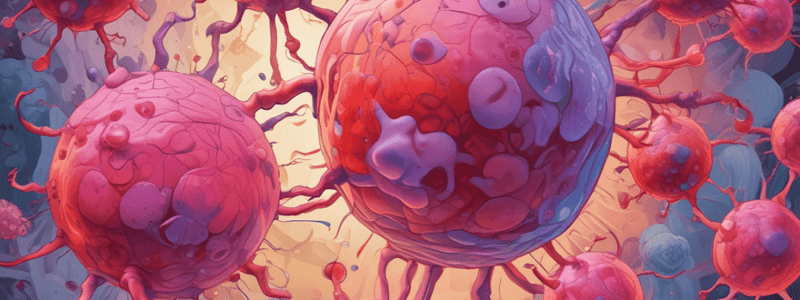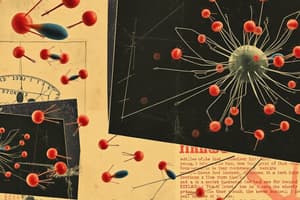Podcast
Questions and Answers
Where do neutrophils circulate?
Where do neutrophils circulate?
- In the tissues
- In the heart
- In the blood (correct)
- In the lungs
What triggers neutrophils to leave the blood vessels?
What triggers neutrophils to leave the blood vessels?
- The presence of nutrients
- The presence of macrophages
- The presence of oxygen
- The presence of bacteria (correct)
What is the main function of macrophages?
What is the main function of macrophages?
- To activate T-cells
- To produce cytokines
- To phagocytose foreign particles (correct)
- To produce antibodies
Why do neutrophils need to leave the blood vessels?
Why do neutrophils need to leave the blood vessels?
What do macrophages notice that triggers their response?
What do macrophages notice that triggers their response?
How do neutrophils get to the site of infection?
How do neutrophils get to the site of infection?
What is the purpose of neutrophils?
What is the purpose of neutrophils?
Where do macrophages typically reside?
Where do macrophages typically reside?
Where does antigen presentation occur?
Where does antigen presentation occur?
What is the direction of lymphatic flow?
What is the direction of lymphatic flow?
Where do all lymphatic vessels eventually drain into?
Where do all lymphatic vessels eventually drain into?
What is the main role of B cells in the immune response?
What is the main role of B cells in the immune response?
How do T cells get back into the blood?
How do T cells get back into the blood?
What do neutrophils release after they do their job?
What do neutrophils release after they do their job?
What do antibodies produced by B cells do?
What do antibodies produced by B cells do?
What type of cells are endothelial cells?
What type of cells are endothelial cells?
Why do neutrophils need to squeeze between endothelial cells?
Why do neutrophils need to squeeze between endothelial cells?
What is the final destination of the lymph fluid before entering the blood?
What is the final destination of the lymph fluid before entering the blood?
What is the function of macrophages in this process?
What is the function of macrophages in this process?
Where do T cells go after getting back into the blood?
Where do T cells go after getting back into the blood?
Why do macrophages need to use a different mode of transport?
Why do macrophages need to use a different mode of transport?
What type of vessel do macrophages use to travel to the lymph node?
What type of vessel do macrophages use to travel to the lymph node?
What is the purpose of neutrophils in the immune response?
What is the purpose of neutrophils in the immune response?
What happens to neutrophils after they eat up bacteria?
What happens to neutrophils after they eat up bacteria?
What is the usual lifespan of neutrophils?
What is the usual lifespan of neutrophils?
Why can't immune cells cross from tissue to blood?
Why can't immune cells cross from tissue to blood?
Flashcards are hidden until you start studying
Study Notes
Neutrophils and Blood Circulation
- Neutrophils circulate in the blood, which circulates in a closed loop.
- Neutrophils are the most common immune cell.
Neutrophil Action in Infection
- Neutrophils do their work when there is an infection in the tissues.
- To get to the infected tissue, neutrophils squeeze out through the cells of the blood vessels.
- Macrophages in the infected tissue release chemical signals that alert endothelial cells lining the blood vessels of the infection.
- Endothelial cells then express proteins that attract neutrophils, which stick to these proteins and squeeze through between the endothelial cells.
- Neutrophils then gobble up bacteria, chew them up, digest them, and eventually die, becoming pus.
Immune Cell Movement
- Immune cells only move from the blood into the tissue, not from the tissue back into the blood.
- Macrophages need to use a different mode of transport to get to B and T cells, which involves entering lymphatic vessels.
Lymphatic System
- Lymphatic vessels have little holes that allow cells, proteins, and other things to get in.
- Macrophages enter lymphatic vessels, which allow them to travel to the nearest lymph node.
- In the lymph node, macrophages present antigens to T cells, which leads to the activation of T cells that can fight the infection.
Antigen Presentation and Immune Response
- Antigen presentation occurs in the lymph node, where macrophages present antigens to T cells.
- Activated T cells then travel through the lymphatic system, eventually entering the blood through the thoracic duct.
- In the blood, T cells follow chemical signals to the infected tissue, where they squeeze through between endothelial cells to fight the infection.
- B cells remain in the lymph node, producing antibodies that can travel to the infected tissue to fight the infection.
Studying That Suits You
Use AI to generate personalized quizzes and flashcards to suit your learning preferences.



